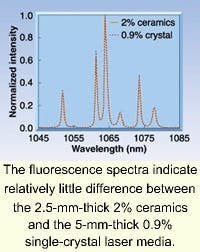The search has been on for some time to obtain high-quality highly transparent Nd:YAG ceramics that can compete with single-crystal Nd:YAG as laser materials, for the most part because of the less-complex manufacturing process. Compared to the single-crystal growth method, the ceramic can be produced with both higher neodymium concentration and a larger-size output. Now the search may be over. Scientists at the University of Electro-Communications (Chofu, Tokyo); The Takuma Works, Konoshima Chemical Co. (Kagawa, Japan); and the Institute of Crystallography of the Russian Academy of Sciences (Moscow, Russia) have developed a diode-laser-end-pumped polycrystalline 2% Nd:YAG ceramic laser with threshold and slope efficiency comparable to that of a 0.9% Nd:YAG single-crystal laser.1
The experimental setup for testing the 2% Nd:YAG ceramic laser included a high-brightness Hamamatsu 2901 laser diode with 1 x 50 µm2 emission profiles as the pump source and a pair of lenses with 8-mm focal length for collimation and focusing. With a 1-W output from the laser diode, about 883 mW of pump power was focused on the end of the sample. The 2.5-mm-thick 2% Nd:YAG ceramic also was coated with a special film on one end to produce the effect of a cavity mirror, and with a 1064-nm antireflection coating on the other end. The output coupler, a concave mirror, had a radius of 250 mm and reflectivity approaching 97%. The cavity length was about 20 mm.
In comparisons of laser output versus input for both laser materials, the researchers found that the threshold for the 2% ceramic was 30 mW, slightly higher than the crystal's 22 mW (see figure). The slope efficiencies for the two materials were 55.4% and 55.2%, respectively. When pumped at 883 mW, the ceramic device produced 465-mW continuous-wave (CW) output at 1064 nm, which corresponds to an optical-to-optical efficiency of 52.7%. The single-crystal laser produced 474-nm output at 1064 nm for the same pump power, with a corresponding optical-to-optical conversion efficiency of 53.7%.
Experiments also showed the peak absorption coefficient of 2% Nd:YAG ceramic to be about 2.3 times larger than that of 9% single crystal Nd:YAG. Another difference involved the main absorption peak for the ceramic, which was centered at 808.56 nm and slightly red-shifted compared to that of the single crystal at 808.48 nm. This occurred because of a slight change in the crystal field in the samples with high neodymium concentration. Another slight red shift was observed in the emission spectra, with the 2% Nd:YAG centered at 1064.2 nm0.1 nm away from the spectrum of the single crystal. The scientists stress, though, that except for the redshift, the two spectra are almost identical.
In tests to examine room-temperature fluorescence of the two materials, the scientists found the respective fluorescence lifetimes for the 2% Nd:YAG ceramic and the 0.9% single crystal to be 184.2 and 248.6 µs. They believe that the difference indicates the occurrence of concentration quenching and the reduction in crystal field symmetry related to large neodymium concentration. Because of these factors, the laser gain for high-concentration ceramics should be lower than that of low-concentration single-crystal laser materials, but the absorption coefficient was actually found to increase almost linearly with increasing neodymium concentration. Another benefit of the ceramic laser material is that the optimum material thickness is reduced because of the high absorption coefficient—in a round trip, the laser beam travels a shorter distance inside the thin laser media so there is less scattering loss. Finally, because the output beam of the laser diode has a large divergence angle, the thin materials have better mode match between the pump beam and the laser oscillation mode.
REFERENCE
- J. Lu et al., Appl. Phys. Lett. 77, 3707 (Dec. 4, 2000).
